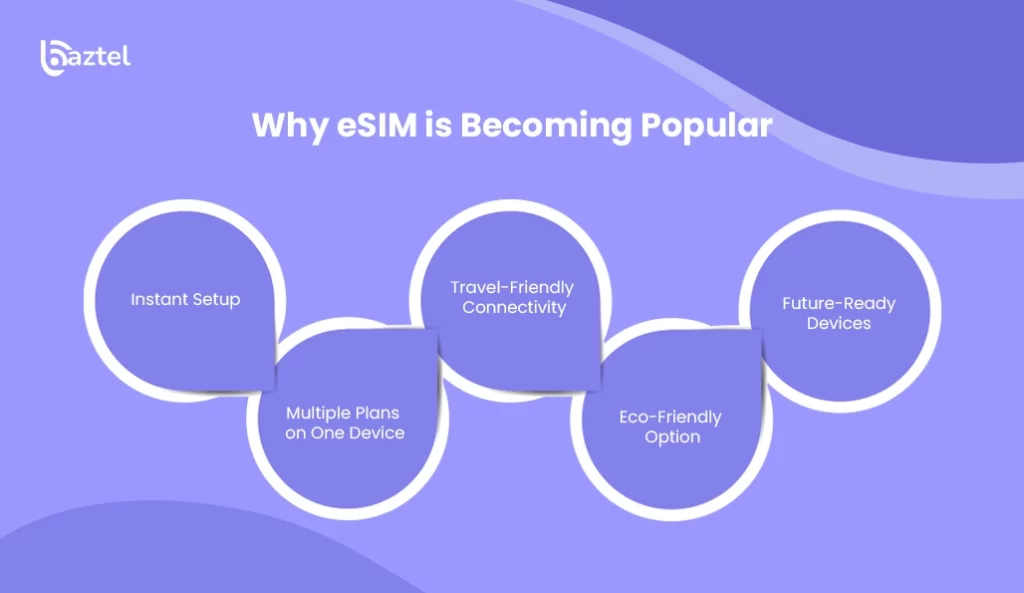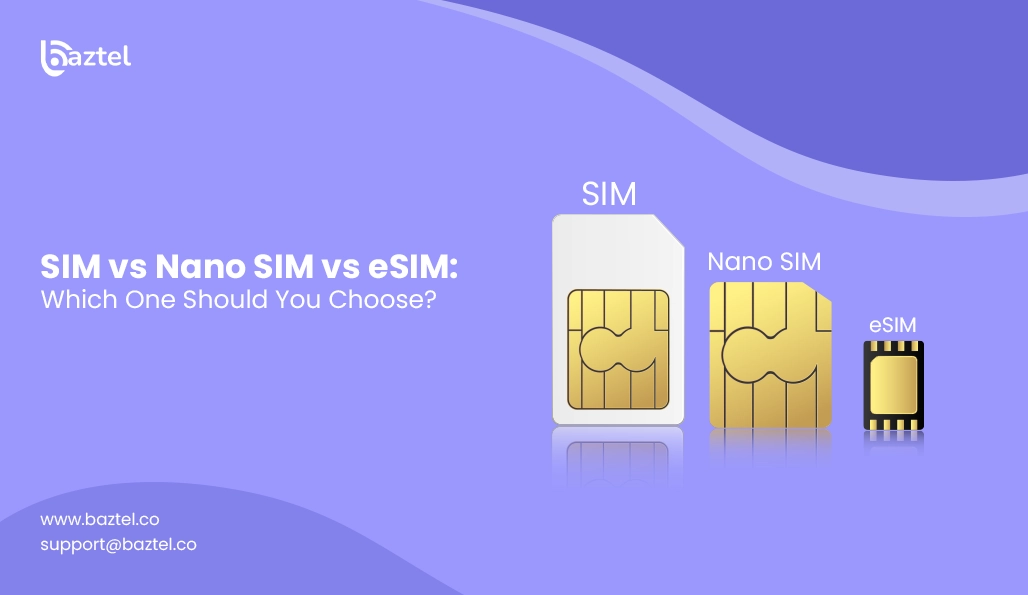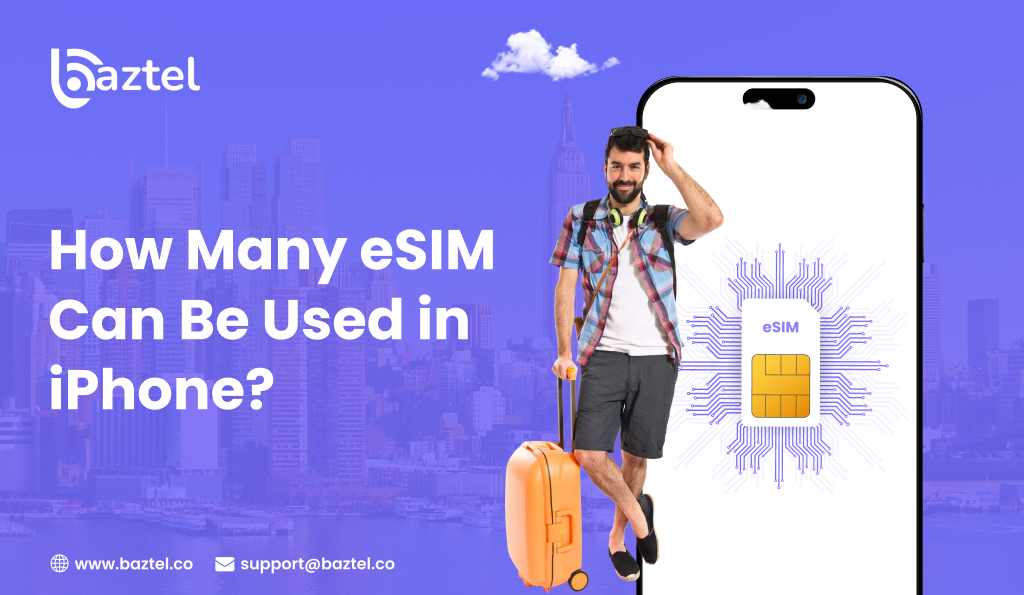In today’s digital age, it is essential to stay connected with everyone. Sending messages, surfing the web, and using a mobile application all rely on a small, yet powerful component: the SIM card.
Over the years, the SIM technique has changed dramatically. When started as a heavy plastic card, Compact has developed into Nano SIM and recently, completely digital eSIM. The shift has given users more flexibility, convenience and protection when it comes to handling their mobile connection.
But today there are so many options available, and by this people are also surprised, and a question arises in their minds: What is the difference between these formats, and which ones are best suited for their needs?
In this blog, we will break down SIM vs Nano SIM vs eSIM, reveal their unique features, and explain with simple words how to choose the right choice for your device and lifestyle.
What is a SIM Card?
A SIM (Subscriber Identity Module) is a chip that allows your phone to connect to your mobile carrier’s network. It stores your number, carrier details, and authentication keys. Without it, you can’t use mobile services like calls, texts, or data.
Evolution of SIM Cards
| SIM Type | Size (approx.) | Common Devices | Status Today |
| Full-size SIM | 85 x 54 mm | Early mobile phones | Obsolete |
| Mini SIM | 25 x 15 mm | 2000s-era smartphones | Rarely used |
| Micro SIM | 15 x 12 mm | Mid-2010s phones | Still used in older models |
| Nano SIM | 12.3 x 8.8 mm | Most modern smartphones | Current standard |
| eSIM | No card (embedded) | Latest devices (smartphones, wearables) | Emerging standard |
As technology advanced, SIM cards became smaller to leave room for bigger batteries and advanced features.
What is a Nano SIM?
Nano SIM is the smallest physical SIM card available today, which was launched in 2012 with Apple’s iPhone 5. The target, only 12.3 x 8.8 mm, changed the large formats and quickly became a global standard for most modern smartphones.
| Pros | Cons |
| Small and efficient | Can be lost or damaged easily |
| Works in almost every phone | Limited to one plan per SIM |
| Easy to replace at carrier stores | Switching carriers requires swapping SIM |
Nano SIMs are still the global standard for most smartphones. If you buy a new phone, it almost certainly supports nano SIM cards.
What is an eSIM?
An eSIM (embedded SIM) is a digital version of the SIM card built directly into your phone, smartwatch, or tablet. You don’t insert or remove it; it’s permanently inside your device. Instead, you activate your plan digitally by scanning a QR code or downloading it from your carrier’s app.
| Pros | Cons |
| Instant activation online | Not supported by all devices |
| Can store multiple carrier profiles | Some carriers still don’t support eSIM |
| Great for international travel | May be tricky to transfer to older phones |
| Eco-friendly (no plastic cards) | Still new in some markets |
Devices That Support eSIM
eSIM is growing rapidly across smartphones, tablets, wearables, and even laptops. Here are the major brands and models currently offering eSIM capability:
Apple
- IPhones: All models are covered, including iPhone XR, XS, XS Max, and the entire iPhone 11, 12, 13, 14 and 15 series.
- iPads: iPad Pro (3rd generation to current models), iPad Air (3rd generation or later), iPad Mini (5th generation or later), and iPad (7th generation or later).
- Wearables: All cellular models of Apple Watch Series 3 to current models.
Samsung
- Smartphones: Galaxy S20 series, NEUR (S20, S21, S22, S23, S24), Galaxy Note 20, Galaxy Z Fold Series, and Galaxy Z Flip Series.
- Tablets: Includes new Galaxy Tab S6, LTE and 5G versions.
- Wearable: Galaxy Watch Active 2, Galaxy Watch 3, Galaxy Watch 4 (LTE version), Galaxy Watch 5, and Galaxy Watch 6.
- Smartphone: All new models, including Pixel 3, Pixel 3A and Pixel 4, 5, 6, 7 and 8 series.
- Pixel folds and pixel tablets also have eSIM support.
Other brands and equipment
- Microsoft Surface: Select Surface Pro X and LTE-competing surface devices.
- Lenovo: Some Thinkpad -Laptop Computers with LTE/5G connection.
- Huawei: Some big equipment like the Huawei P40 series and later.
- Wearables and IoT: Many smartwatches, workouts and connected IoTs now integrate eSIM for free connection.
The widespread adoption indicates that eSIMs are no longer only for premium phones, expanding into tablets, carriers and even laptops, which opens the possibilities for the future with no physical sim.
SIM vs Nano SIM vs eSIM: Key Differences
Choosing the right SIM can affect your convenience and general experience. Traditional physical SIMs (standard and nano) have done good work over the years, but eSIMs (digital SIMs) are quickly becoming a popular alternative for modern smartphones. Below is the detailed comparison of SIM vs Nano Sim vs eSIM:
| Feature | SIM (Physical) | Nano SIM (Physical) | eSIM (Digital) |
| Form Factor | Large removable card | Smallest physical SIM (12.3 x 8.8 mm) | Embedded chip inside device, no physical card required |
| Activation | Insert into device tray and restart | Insert into tray; device detects automatically | Scan QR code or download plan from carrier/app |
| Flexibility | One SIM = one plan | One SIM = one plan | Multiple plans on one device; switch instantly |
| Durability | Can be lost, bent, or damaged | Can be lost or damaged | Secure and permanent inside device; not physically removable |
| Convenience | Carrier visit or delivery needed | Similar to SIM; requires physical handling | Instant online setup; no store visit required |
| Travel Use | Must buy local SIM abroad | Must buy local SIM abroad | Activate local/international plans instantly |
| Eco Impact | Generates plastic waste | Less plastic than full SIM but still physical | Environmentally friendly; no plastic or shipping waste |
| Device Support | Works in most devices | Supported by nearly all modern smartphones | Supported on iPhone XR+, Galaxy S20+, Pixel 3+, wearables |
| Security | Can be stolen or cloned | Can be stolen or cloned | Harder to steal or clone; safer than physical SIM |
| Cost Factor | Low cost, but replacements may incur fees | Low cost, but replacing a lost nano SIM may cost extra | Usually free; some carriers may charge for transfers |
| Future Outlook | Still widely used, especially in older devices | Current standard for most smartphones | Considered the future; many devices moving to eSIM-only |
While physical SIMs (standard and nano) are widely used due to simplicity and low costs, eSIMs bring a revolution in mobile connection. They provide immediate layouts, many plan supports, increased safety and environmentally friendly benefits. For travelers or those who look at their devices for evidence of the future, using an eSIM is a smart alternative.
Which One Should You Choose: SIM vs Nano SIM vs eSIM
The difference between a SIM, Nano SIM and eSIM is largely planned to use your device, your lifestyle and you use your mobile connection. Here’s a detailed guide to help you make the right choice:
| User Type | Recommended Option | Why This Works Best |
| Older Phone Users | Nano SIM | Older devices often do not support eSIM, making Nano SIM the most reliable and widely compatible choice. |
| New Smartphone Owners | eSIM | Modern devices supports eSIM and offer immediate activation, with many schemes and connection solutions prepared for the future. |
| Frequent Travelers | eSIM | With eSIM, you can immediately add local or international computer programs without removing your SIM, saving time and avoiding roaming fees. |
| Dual SIM Users | Nano SIM + eSIM Combo | Combining a nano SIM with an eSIM allows you to keep a personal and a work number active simultaneously or separate voice and data plans. |
| Tech Minimalists | eSIM | eSIM eliminates the risk of losing or damaging a physical SIM card while keeping connectivity simple and hassle-free. |
Key Considerations
- Device Compatibility – Check if your phone supports eSIM. The latest iPhones, the Samsung Galaxy S20+ series, and the Google Pixel 3+ device support eSIM. The old phone will require a Nano SIM.
- Travel frequency – eSIM is ideal for persistent passengers, as it provides quick access to local networks abroad without physically switching the SIM card.
- Multiple numbers – If you manage both work and personal numbers on the same device, a Nano SIM + eSIM combination provides maximum flexibility.
- Future protection- eSIM becomes standard for new units. eSIM ensures that your device is ready for future transport technologies.
When evaluating SIM vs Nano SIM vs. eSIM, there is no universal solution for which one you should choose. Your choice depends on unit support, use habits and lifestyle needs. Nano SIM is still a safe, reliable alternative, while eSIMs provide unmatched function, flexibility and future protection, especially for travelers and double-SIM users.
Why eSIM is Becoming Popular

The use of eSIM technology is growing rapidly, as it provides more than just convenience. As mobile devices develop, eSIM changes how to add and manage many schemes and travel globally. When you compare SIM against Nano SIM against eSIM, it is clear that eSIM provides unique benefits that form the future of mobile connection.
1. Instant Setup
Unlike traditional SIM cards, which need to go to a carrier, and you can wait for delivery or physically insert the card, an eSIM can be activated immediately. By scanning the QR code or downloading a plan from an app, users can start using mobile data in minutes. It is especially useful for those who need immediate connection.
2. Multiple Plans on One Device
eSIM lets you save multiple profiles at the same time. You can easily alternate between individual and work figures or between different carriers without physically changing SIM cards. For example, you can actively keep your home number when you add a temporary international travel plan.
3. Travel-Friendly Connectivity
A major advantage of eSIM flexibility is for passengers. Instead of buying local SIMs, you can buy an online data plan and activate it immediately. It avoids expensive roaming fees and maintains its primary number actively for conversations and messages.
4. Eco-Friendly Option
Physical SIM cards contribute to plastic waste due to shipping and packaging generated from those cards. The environmental issues of plastic waste can be completely eliminated with an eSIM, making it a more sustainable option for environmentally conscious users and companies.
5. Future-Ready Devices
Many tech companies are shifting toward eSIM-only devices. Apple’s U.S. iPhone 14 and 15 models, for example, no longer have physical SIM slots. As several manufacturers follow suit, eSIM is expected to become a global standard, which completely replaces traditional Sims.
When comparing SIM vs Nano SIM vs eSIM, the latter provides instant setup, flexibility, sustainability and future readiness. eSIM is the best option for the convenience-focused, world-traveling, eco-friendly customer. eSIM is not a feature; it is the future of cellular connectivity.
Using a Nano SIM and eSIM Together
You can use a nano SIM and an eSIM together! Many new smartphones support Dual SIM, where you use a physical SIM and a digital eSIM at the same time. This makes it easy to manage many numbers or schemes without switching the SIM card.
Benefits of Using Dual SIM (Nano SIM + eSIM)
- Various work and personal lines, one dedicated to business calls and the other for personal use.
- Add a local or international data plan through an eSIM while traveling, without removing the travel-friendly connection-to-home SIM.
- Custom speech and data plan: Assign a SIM for calls and another for data, and optimize your mobile plan for cost and convenience.
Real-World Example
Imagine living in North America and owning an iPhone 13, which supports the eSIM, and the carrier is unlocked. Your device can save up to eight eSIM profiles. You travel again and again, and every time you go to another country, you will avoid switching your nano SIM. Instead, you simply download an eSIM scheme from suppliers like Baztel for your destination. Within minutes, the phone is connected to the local network, so you can be online, whether you are for navigation, communication or work.
Using a Nano SIM with an eSIM brings together the two best types of mobile connection: a traditional SIM and the digital eSIM. The hybrid solution, when comparing SIM vs. Nano SIM vs. eSIM, provides unimpeachable solutions, including flexibility for your travels and support for multi-number users.
FAQs on SIM vs Nano SIM vs eSIM
1. Can I use both eSIM and physical sim at the same time?
Yes. Many new smartphones support Double SIM mode, so you can use a Nano SIM and an eSIM at the same time. This is ideal if you want to keep your personal and work activity numbers active on the same phone.
2. Is eSIM safe?
Absolutely. In fact, eSIM is safer than a traditional sim because it cannot be stolen, clone or physically damaged. Since it is built in the unit, it reduces the risk of abuse.
3. What happens if I switch a phone with an eSIM?
When you go to a new device, you can simply download or move your eSIM profile through the carrier. Some devices also allow direct eSIM transmission, making the process faster.
4. Do all the carriers support eSIM?
Not everyone, but the number is increasing rapidly all over the world. Large carriers in the United States, Europe and Asia already support eSIM, and much more adds compatibility every year.
5. Can I travel abroad with just one SIM?
Yes. eSIM is a great alternative for international travelers. You can buy and activate a local or global data plan before or after reaching the destination, avoiding expensive roaming costs that keep your home number active.
Conclusion
Mobile connection has evolved dramatically, from large, credit card-shaped SIMs in the 1990s to today’s small Nano SIM and full digital eSIM. Each version represents a step toward making our devices smaller, smart and more effective.
Which one should you choose?
- If your device still needs it, hold it with a Nano-SIM. It is currently the most used and supported SIM card type around the world.
- If your smartphone, tablet or smartwatch supports it, you can upgrade eSIM. eSIM technology gives you instant setup, a simple carrier, an environmentally friendly advantage, and a global travel connection.
Why it does matter?
When you compare SIM vs Nano SIM vs eSIM, the direction of the mobile industry is clear, i.e., eSIM. Support and device companies, such as Apple, Samsung and Google, are heading towards eSIM; physical SIMs can soon become obsolete.
Whether you use a traditional SIM, Nano SIM or eSIM, the final goal is the same: to keep in touch anywhere at any time. But if your device supports it, eSIM means you are already ready for the next era with mobile connection.
Blog Author
Peter
Peter started BazTel.co to make mobile internet easier for travellers. He noticed how tough it was to find good network options while visiting new countries. That’s when he built BazTel — a place where anyone can buy eSIMs online without confusion or long steps. He believes tech should be simple and useful, not complicated. When he’s free, he likes to travel, test BazTel himself, and keep improving it based on real user problems.

 Botswana
Botswana Zambia
Zambia Congo
Congo Colombia
Colombia China mainland
China mainland Chile
Chile Chad
Chad Central African Republic
Central African Republic Canada
Canada Cameroon
Cameroon Cambodia
Cambodia Burkina Faso
Burkina Faso Bulgaria
Bulgaria Brunei Darussalam
Brunei Darussalam Brazil
Brazil Aland Islands
Aland Islands Bosnia and Herzegovina
Bosnia and Herzegovina Bolivia
Bolivia Belgium
Belgium Belarus
Belarus Bangladesh
Bangladesh Bahrain
Bahrain Azerbaijan
Azerbaijan Austria
Austria Australia
Australia Armenia
Armenia Argentina
Argentina Algeria
Algeria



